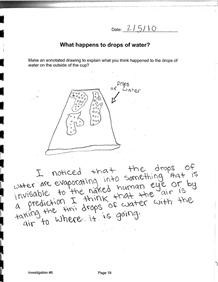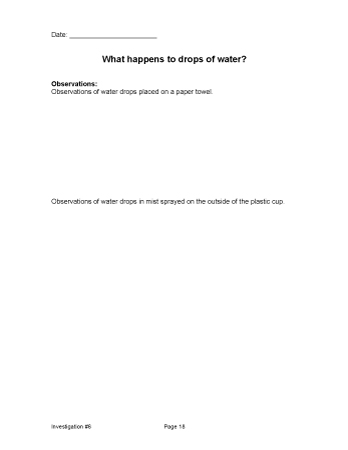What happens to the water?
Plan Investigation 6
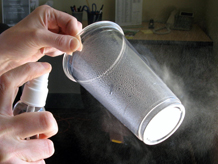
In the previous investigation, students found evidence that when salt disappears during dissolving, it is still present. They proposed an explanation: that the salt particles were too small and too spread out to see. There are connections between the salt students dissolved and evaporation.
Evaporation happens before our very eyes. – the fog on the bathroom mirror clears, our clothing dries the puddle on the sidewalk shrinks. What happened to the water? and how does evaporation happen anyway? What makes it possible?
Formative Assessment
What do your students’ think happens to water drops when they disappear from the outside of a cup?
Available online at inquiryproject.terc.edu
What do your students’ think happens to water drops when they disappear from the outside of a cup?
Look for evidence of students’ ideas in their annotated drawings on the notebook page What happens to drops of water?
As you interpret annotated drawings, try to gain insight into each student’s idea about evaporation.
Typically students this age may think that water that evaporates (disappears)
- has dried up and is nothing — it doesn’t exist
- has soaked into the surface material, e.g., plastic or paper towel
- has gone into the air and will become a cloud
- has transformed into drops too small to see that are part of air
Students who use the term “evaporation” may hold different ideas about what the word means.
Next steps (in feedback or discussion) might be to ask students to clarify anything you don’t fully understand, to provide more details or elaborate explanations, to explain what “evaporation” means without using the term.
In both processes, dissolving and evaporation, matter separates itself into particles that are too small to see. Also in both processes, weight can be used to track the presence (or absence) of these particles.
Students will not arrive at definitive answers about the evaporation process today, but after they observe the evaporation of water from a wet paper towel and from the surface of a plastic cup, they will continue the practice of proposing explanations based on their observations, prior experience and reasoning. They will engage in the practice of modeling – making the invisible visible – when they make an annotated drawing that describes what they think happens to the water when it evaporates.
By the end of this investigation, students will have formulated their initial ideas about the process of evaporation. They communicate their ideas through an annotated drawing about what happens to water when it evaporates.
Learning Goals
- To express initial ideas about the process of evaporation by making an annotated drawing
| Sequence of experiences | ||
|---|---|---|
| 1. Ask the question | All Class | 10 Mins |
| 2. Explore | Individual | 10 Mins |
| 3. Make an annotated drawing | Individual | 15 Mins |
| 4. Make meaning | All Class | 10 Mins |
Materials and Preparation
Preparation:
- Read Annotated Drawings (See Resource Quick Links). Create an Annotated Drawings poster. Save poster for reuse in later investigations.
For the class:
- Post the investigation question in a place where all students can see it.
- 1 spray mister filled with water
- 1 paper towel

For each group:
- 1 12oz cup approximately 1/4 full of water
- 1 6in strip of masking tape
- 4 1cc droppers (1cc small syringe)
- 4 paper towels
- 4 magnifiers
- 4 12oz clear plastic cups
1. Ask the question
In the previous session students investigated the transformation of salt from a solid granular material into something they could no longer see. They used weight measurements to argue that the salt was still present.
Review with students some of the important ideas from the last investigation when salt was dissolved.
- When salt dissolves in water it separates into particles too small to see.
- We can use weight as evidence that salt is still there, even if we can't see it.
- The salt particles take up space, even though they are too small to see.
- Each particle became smaller, but since the weight remained the same, the number of particles must have increased.
- Salt is matter before it is dissolved and it is still matter after it dissolves.
Connect today's investigation to the previous one. Today, the class will investigate another kind of transformation with some similarities to salt dissolving in water. Elicit students' ideas on evaporation with the following question:
Examples of possible responses:
- The puddle evaporates because the sun dried it up and it is now simply gone.
- The puddle has turned in to clouds.
- The puddle is in the air.
Explain that the class will continue to work with water, and that over the next few investigations they'll be taking a closer look at what happens when water disappears.
Introduce the investigation question:
What happens to the water?
Demonstrate the following for students:
- Soak one paper towel and squeeze it gently to remove any water not fully absorbed by the paper, so no drops will drip from the wet towel.
- Weigh the wet paper towel.
- Announce the weight to students.
- Drape the wet towel over something where it can remain until later in the class.
2. Explore
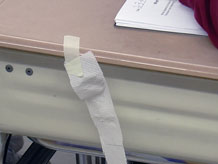
Distribute a set of materials to each group.
Drops on a paper towel
Have each student:
- Use the droppers to put 4 drops of water (spread apart) on a paper towel.
- Tape a corner of the paper towel to the edge of the desk, so it hangs freely over the side.
Mist on a plastic cup
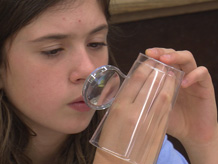
Have each student hold up an empty 12oz plastic cup. With the spray mister about 12 inches away, spray the outside of each student's cup. These drops are very tiny compared with the drops students placed on the paper towels.
Have students inspect the drops carefully with their magnifiers.
Think of these drops as very tiny puddles. Is anything changing?
Ask students to find the smallest drop they can see and stare at it for a while. The drop will become smaller and should disappear as they watch.
Have students record their observations on [What happens to drops of water?] in their Science Notebooks.
3. Make an annotated drawing
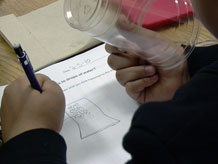
Students will now address the investigation question, What happened to the water?, by making a special type of drawing called an annotated drawing. Scientists use annotated drawings to explain something they have not been able to directly observe. It allows them to share their best thinking and reasoning about how something happens.
Students have observed that mist sprayed on the side of the cup disappears. They have not observed exactly what happens to the water once it has disappeared, so their explanations will have to depend on their reasoning about what they think happened. They develop and share their explanation by making their own annotated drawing.
Refer students to the sheet labeled Annotated Drawings at the back of the Science Notebook. The sheet highlights the important elements of an annotated drawing.
Review the key points of an annotated drawing with them, and then put the Annotated Drawings poster in a place where all students can see it.
On the notebook page [What happens to drops of water?], students make an annotated drawing that explains what they think happened to the water that disappeared from the side of the plastic cup.
As students are working, circulate among them to get a sense of the range of ideas they are developing. This can help you to highlight some contrasting ideas during the discussion.
4. Make meaning
Ask students to check their paper towels.
Purpose of the discussion
The purpose of this discussion is for students to construct explanations of what happened to the drops of water, explanations that are consistent with their observations and evidence.
Engage students in the focus question
Earlier we used evidence to explain what happened to salt when it dissolved in water. Now let’s use evidence to explain what we think happened to the water drops on our paper towels and the outside of the plastic cups.
Earlier we used weight as evidence to explain what happened to salt when it dissolved in water. Now let’s use evidence to explain the disappearance of water drops you put on the paper towel or sprayed on the outside of the cup. Do you think the water still exists after it disappeared or has it been destroyed?
Provide time for students to consider their position or argument and the reasoning to back it up. Students may offer the following:
- The water has moved into the air. (Students may suggest that the existence of clouds supports this claim.)
- The water has moved from the surface to inside the plastic or inside the paper. (What evidence can students point to to support this claim?)
- The water is gone; it no longer exists.
If the evaporated water still exists, and where do you think it is now?
If the evaporated water still exists, why do you think we can't see it?
Who thinks water is destroyed by evaporation and why do you think so?
Remind students to support their position or arguments with evidence or reasoning. They should refer to their annotated drawings and notebook entries as they make their claims and provide their reasoning.
Weigh the paper towel: If some students think the water has moved inside the plastic or paper, weigh the paper towel saturated at the start of the investigation. Very likely it is now dry or almost dry. The weight measurement, which should be 3g to 5g less than the wet weight, provides evidence that evaporated water does not move from the surface of a material to inside of it.
How might we test the idea that the water still exists after it evaporates, or that evaporation destroys water?
- Make evaporation happen in a closed system, and look for evidence that the water still exists.
Summarize the discussion and recap the investigation
Using the same language students have used, summarize their main ideas. Include the following key idea:
- The only evidence we have is that evaporated water does not just move from the surface to the inside of a material. The weight of the saturated paper towel became less as water evaporated.
- There is no clear answer to the question of whether or not evaporated water has been destroyed, but the class will continue to explore that question in the science classes that follow.
As you recap the investigation, be sure there is understanding of these points:
- Today you watched drops of water on a plastic cup became smaller; some disappeared.
- You also put drops of water on a paper towel, they also disappeared.
- This disappearance of water in the classroom matches other experiences you have had: wet clothing dries; rain puddles disappear.
- We can claim that evaporated water does not move from the surface to inside a material. The evidence for this is that the weight of the paper towel became less as water evaporated from it.


